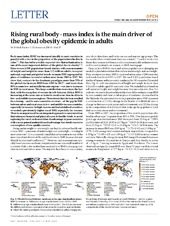Rising rural body-mass index is the main driver of the global obesity epidemic in adults
| dc.contributor.author | Bixby, Honor | en_US |
| dc.contributor.author | Bentham, James | en_US |
| dc.contributor.author | Zhou, Bin | en_US |
| dc.contributor.author | Di Cesare, Mariachiara | en_US |
| dc.contributor.author | Paciorek, Christopher J. | en_US |
| dc.contributor.author | Bennett, James E. | en_US |
| dc.contributor.author | Taddei, Cristina | en_US |
| dc.contributor.author | Stevens, Gretchen A. | en_US |
| dc.contributor.author | Rodriguez-Martinez, Andrea | en_US |
| dc.contributor.author | Carrillo-Larco, Rodrigo M. | en_US |
| dc.contributor.author | Andersen, Lars Bo | en_US |
| dc.contributor.author | Anderssen, Sigmund Alfred | en_US |
| dc.contributor.author | Ekelund, Ulf | en_US |
| dc.contributor.author | Kolle, Elin | en_US |
| dc.contributor.author | Steene-Johannessen, Jostein | en_US |
| dc.contributor.author | Tarp, Jakob | en_US |
| dc.contributor.author | Ariansen, Inger | en_US |
| dc.contributor.author | Biehl, Anna Månsson | en_US |
| dc.contributor.author | Graff-Iversen, Sidsel | en_US |
| dc.contributor.author | Meisfjord, Jørgen Rajan | en_US |
| dc.contributor.author | Bjertness, Espen | en_US |
| dc.contributor.author | Bjertness, Marius Bergsmark | en_US |
| dc.contributor.author | Meyer, Haakon E | en_US |
| dc.contributor.author | Haugsgjerd, Teresa Risan | en_US |
| dc.contributor.author | Tell, Grethe S. | en_US |
| dc.contributor.author | Janszky, Imre | en_US |
| dc.contributor.author | Krokstad, Steinar | en_US |
| dc.contributor.author | Laugsand, Lars Erik | en_US |
| dc.contributor.author | Sen, Abhijit | en_US |
| dc.contributor.author | Vatten, Lars Johan | en_US |
| dc.contributor.author | Mathiesen, Ellisiv B. | en_US |
| dc.contributor.author | Wilsgaard, Tom | en_US |
| dc.contributor.author | Khang, Young-Ho | en_US |
| dc.contributor.author | Soric, Maroje | en_US |
| dc.contributor.author | Gregg, Edward W. | en_US |
| dc.contributor.author | Miranda, J. Jaime | en_US |
| dc.contributor.author | Bhutta, Zulfiqar A. | en_US |
| dc.contributor.author | Savin, Stefan | en_US |
| dc.contributor.author | Sophiea, Marisa K. | en_US |
| dc.contributor.author | Iurilli, Maria L. C. | en_US |
| dc.contributor.author | Solomon, Bethlehem D. | en_US |
| dc.contributor.author | Cowan, Melanie J. | en_US |
| dc.contributor.author | Riley, Leanne M. | en_US |
| dc.contributor.author | Danaei, Goodarz | en_US |
| dc.contributor.author | Bovet, Pascal | en_US |
| dc.contributor.author | Chirita-Emandi, Adela | en_US |
| dc.contributor.author | Hambleton, Ian R | en_US |
| dc.contributor.author | Hayes, Alison J | en_US |
| dc.contributor.author | Ikeda, Nayu | en_US |
| dc.contributor.author | Kengne, Andre P | en_US |
| dc.contributor.author | Laxmaiah, Avula | en_US |
| dc.date.accessioned | 2020-08-05T09:42:06Z | |
| dc.date.available | 2020-08-05T09:42:06Z | |
| dc.date.issued | 2019 | |
| dc.Published | Bixby H, Bentham J, Zhou B, Di Cesare M, Paciorek CJ, Bennett JE, Taddei C, Stevens GA, Rodriguez-Martinez, Carrillo-Larco RM, Andersen LB, Anderssen SA, Ekelund U, Kolle E, Steene-Johannessen J, Tarp J, Ariansen I, Biehl A, Graff-Iversen S, Meisfjord JR, Bjertness E, Bjertness MB, Meyer HE, Haugsgjerd TR, Tell GST, Janszky I, Krokstad SK, Laugsand LE, Sen A, Vatten LJ, Mathiesen EB, Wilsgaard T, Khang Y, Soric M, Gregg, Miranda JJ, Bhutta ZA, Savin S, Sophiea, Iurilli, Solomon, Cowan MJ, Riley LM, Danaei G, Bovet P, Chirita-Emandi A, Hambleton IR, Hayes AJ, Ikeda N, Kengne AP, Laxmaiah A. Rising rural body-mass index is the main driver of the global obesity epidemic in adults. Nature. 2019;569:260-264 | eng |
| dc.identifier.issn | 1476-4687 | |
| dc.identifier.issn | 0028-0836 | |
| dc.identifier.uri | https://hdl.handle.net/1956/23442 | |
| dc.description.abstract | Body-mass index (BMI) has increased steadily in most countries in parallel with a rise in the proportion of the population who live in cities1,2. This has led to a widely reported view that urbanization is one of the most important drivers of the global rise in obesity3,4,5,6. Here we use 2,009 population-based studies, with measurements of height and weight in more than 112 million adults, to report national, regional and global trends in mean BMI segregated by place of residence (a rural or urban area) from 1985 to 2017. We show that, contrary to the dominant paradigm, more than 55% of the global rise in mean BMI from 1985 to 2017—and more than 80% in some low- and middle-income regions—was due to increases in BMI in rural areas. This large contribution stems from the fact that, with the exception of women in sub-Saharan Africa, BMI is increasing at the same rate or faster in rural areas than in cities in low- and middle-income regions. These trends have in turn resulted in a closing—and in some countries reversal—of the gap in BMI between urban and rural areas in low- and middle-income countries, especially for women. In high-income and industrialized countries, we noted a persistently higher rural BMI, especially for women. There is an urgent need for an integrated approach to rural nutrition that enhances financial and physical access to healthy foods, to avoid replacing the rural undernutrition disadvantage in poor countries with a more general malnutrition disadvantage that entails excessive consumption of low-quality calories. | en_US |
| dc.language.iso | eng | eng |
| dc.publisher | Springer Nature | eng |
| dc.rights | Attribution CC BY | eng |
| dc.rights.uri | http://creativecommons.org/licenses/by/4.0 | eng |
| dc.title | Rising rural body-mass index is the main driver of the global obesity epidemic in adults | en_US |
| dc.type | Peer reviewed | |
| dc.type | Journal article | |
| dc.date.updated | 2020-01-28T09:56:42Z | |
| dc.description.version | publishedVersion | en_US |
| dc.rights.holder | Copyright 2019 The Author(s) | |
| dc.identifier.doi | https://doi.org/10.1038/s41586-019-1171-x | |
| dc.identifier.cristin | 1770062 | |
| dc.source.journal | Nature |

